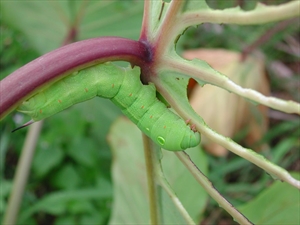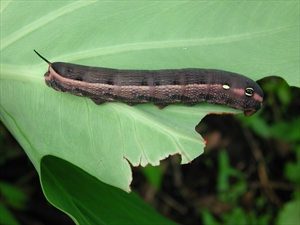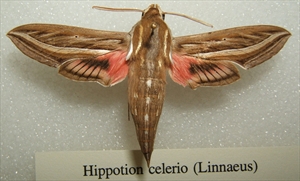- Widespread distribution. In tropical and temperate Asia, Oceania. An important pest.
- Eggs are laid on the leaves and petioles. Mature caterpillars eat between veins, sometimes all the leaf.
- Look for the horn and the large eye spots.
- Outbreaks uncommon because of natural enemies, and other control measure not needed.
- Natural enemies: parasitoid wasps.
- Cultural control: visit garden regularly; handpick caterpillars; allow chickens into the taro fields.
- Chemical control: not usually required. If needed, use PDPs: neem, pyrethrum, or chilli; use products from bacteria, e.g., spinosad or Bt (Bacillus thuringiensis) on young caterpillars. Alternatively, use synthetic pyrethroids, but likely to kill natural enemies.
Pacific Pests, Pathogens, Weeds & Pesticides - Online edition
Pacific Pests, Pathogens, Weeds & Pesticides
Taro hornworm (032)
Taro hornworm
Hippotion celerio. It is a member of the Sphingidae.
AUTHORS Helen Tsatsia & Grahame Jackson
Information from Diongzon, Jr, Gapasin DP (1981) Biology of taro hornworm, Hippotion celerio L. Annals of Tropical Research. (https://annalsoftropicalresearch.com/biology-of-taro-hornworm-hippotion-celerio-l/); and from Carmichael A, et al. (2008) TaroPest: an illustrated guide to pests and diseases of taro in the South Pacific. ACIAR Monograph No. 132, 76 pp. (https://lrd.spc.int/about-lrd/lrd-project-partners/taropest). Photo 3 Mike Furlong, University of Queensland, Brisbane. Photo 5 Wikipedia. (http://en.wikipedia.org/wiki/Hippotion_celerio). Photo 5 Mani Mua, SPC, Sigatoka Research Station, Fiji.
Produced with support from the Australian Centre for International Agricultural Research under project PC/2010/090: Strengthening integrated crop management research in the Pacific Islands in support of sustainable intensification of high-value crop production, implemented by the University of Queensland and the Secretariat of the Pacific Community.









